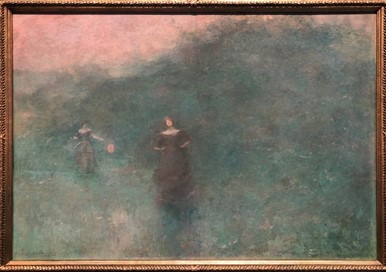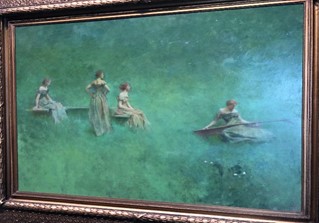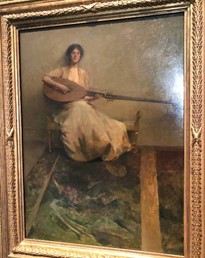ART REVIEW: Dewing’s Poetic World
Alexandra Plummer
Thomas Wilmer Dewing is not a household name. When one thinks of the great Impressionists of the mid-19th century— Monet, Degas, Renoir, Manet — Dewing does not come to mind. Before deciding to visit his exhibition, I had never even heard of him.
Dewing was born into a modest milieu in Boston in 1851. At age 14, he was apprenticed to a lithographer to support his mother and siblings, after the death of his alcoholic father (Smithsonian American Art Museum). Despite his circumstances, he left for Paris to study at the Académie Julian in 1876. The Académie, founded in 1868 by Rodolfe Julian, was an alternative training center to the Ecole des Beaux Arts, where students were encouraged to explore without fear of, “…drudgery, uncaring or outdated teaching, and strenuous career- oriented rivalry, with a make-or-break situation at the end of three or four years” (Russell). Unlike the Ecole des Beaux Arts, the Académie welcomed male and female students alike. After moving to New York City, upon his return, he spent his summers at an artist colony in Cornish, New Hampshire — frequented by the likes of Isadora Duncan and Charles Adams Platt. It is there that he established a friendship with Charles Lang Freer, who found refuge in Dewing’s friendship and gorgeous paintings, and whose gallery now features Dewing’s most famous works (Dewing’s Poetic World).

“Before Sunrise,” Thomas Wilmer Dewing
One painting featured in the exhibition, “Before Sunrise,” particularlynods toward Dewing’s training at the Académie Julian at the height of Impressionism. Two women, one holding a paper lantern, seemingly glide through an amorphous green meadow — barely visible, as the sun has yet to fully rise. The piece is the very definition of Impressionism: utterly imperfect. It is an open composition, comprised of thin, visible brushstrokes, and puts emphasis on the ever- changing quality of light. The rosy pink sky makes it seem as though the sun could rise at any moment, and looking at it, I found myself waiting for the sky to change from pink to red to orange to yellow to blue. The painting’s, “…quickly applied brush strokes give that painterly illusion of movement and spontaneity” (Caves). Dewing was a master of light play, and made a series of paintings depicting the different times of day; characterized by light and the color of the sky.
Dewing once described his artistic sphere as a, “poetic and imaginative world where a few choice spirits live” (Dewing’s Poetic World). That world features gorgeous landscapes and spare interiors alike, and the few choice spirits that inhabit it appear in the form of tall, long-necked, tiny-waisted women — his “Dewing Girls” (Lawrence). Though occasionally depicted reading, painting, or playing musical instruments, the majority of them simply stare off into space, giving them an enigmatic edge. Dewing claimed that as an artist, it was important that his models have “brains” (Dewing s Poetic World), which some attribute to his wife’s influence. A fellow artist, Maria Oakey Dewing, helped promote her husband’s career and some say, “…influenced the style and subject of his art, perhaps even to the point of painting parts of his large commissioned works” (Smith).
However, that is not to say that Dewing’s works bear any type of feminist significance. Though he did not objectify women to the extent of his contemporaries, he painted quite a few nude paintings from the perspective of a very male gaze, and portrayed women as, “…beautiful symbols of an aesthetically oriented inner life that was separate from the world of commerce and social interaction” (Brooklyn Museum). While Renoir was painting his voluptuous models with breasts falling out of their tunics, Manet his “Olympia,” and Degas his models emerging from the bath, Dewing was painting his beautiful ghosts — his own breed of objectification.
Dewing’s summers in New Hampshire inspired his more ethereal works, featuring lush landscapes and his “Dewing Girls” (Lawrence) dressed in off-the-shoulder gowns — often resembling Greek robes — assuming artful poses, often with lanterns, garlands or musical instruments. Many of these works suggest a slight flirtation with abstraction, as landscape starts to blend with model — adding to the dreamlike quality of Dewing’s paintings. He mounted these works in striking gilded frames, designed by his friend and patron, architect Stanford White (Smith).

“The Lute,” Thomas Wilmer Dewing, 1904
My favorite painting featured in the exhibition is entitled “The Lute.” It was one of the final landscapes that Dewing painted in Cornish, and is a kind of compilation of all his creative influences — the Tonalist movement, Japanese Ukiyo-e, and Johannes Vermeer. It features four of his “Dewing Girls” (Lawrence) set against a green gossamer backdrop; one of them holding a lute. Three of the women are situated in a kind of (I say “kind of” as they do not interact with one another) group at one side of the painting, as the lute player sits by herself on the other.
This painting is a prime example of Dewing’s work with Tonalism — “an American art movement of the 1880s in which artists painted landscapes with an overall tone of color, spread over the entire surface like an atmosphere of mist” (Jordan) — as there appears to be a layer of mist spanning the width of the canvas. The oil on wood panel only adds to this illusion, to the point that when I first approached the painting, I thought it was dripping. Though the painting gives the impression of a lush landscape, its foliage has no real definition, and were it not for the four tiny, white flowers in the bottom right corner and the outline of a bench that two of the four women sit on, the women would appear floating in a sea of green.
One can certainly draw parallels between Ukiyo-e — “a Japanese art movement that flourished from the 17th to the 19th century and produced paintings and prints depicting the everyday life and interests of the common people” (Merriam-Webster) — and Dewing’s work, especially considering his training at the Académie Julian at the height of Japonisme. Traditional Ukiyo-e, “was not meant to portray real life but rather the artist’s viewpoint” (ITravelWithArt). That is true for Dewing’s art, as well. Why his paintings are referred to as “dreamscapes” (Lawrence) — they are not realistic depictions, but simply figments of his poetic world.

“Girl with Lute,” Thomas Wilmer Dewing, 1904-05
Dewing was greatly influenced by Dutch painter Johannes Vermeer — another fan of depicting thoughtful women. The lute was one of his favorite instruments to portray in paintings for its vast symbolic purposes (Rech). It is the key to understanding this painting, which is so frustrating because there are so many possibilities as to its significance. However, I have narrowed it down to two: love and misfortune. There is more evidence to speak to the former as the likely solution, as Dewing made art to transport audiences out of their everyday lives and into his poetic world — his utopia. If so, maybe the lute is an instrument of the divine. However, I get the feeling that this lute is not symbolic for love and harmony. Why is one of the women unable to look up from the ground? Why is another peering at the lute player; hands on hips? She must be doing something wrong, no? Maybe, if the lute player plucks a string, all earthly misfortunes will come streaming back. Maybe, she is tempting fate.
Though I adore “The Lute,” and now consider Dewing as one of my favorite Impressionists, I cannot say that I agree with his concept of utopia and cannot see any kind of underlying feminist agenda to his work. Do not get me wrong, his landscapes take my breath away, and his portrayal of women is more intriguing than most — he allows them a mind of their own — however he does not give them a voice. In fact, he actively takes it away by portraying his subjects as solitary mutes who stare off into space. It is clear that they have “brains” (Dewing’s Poetic World), they just are not allowed to use them. And though it may be overshadowed by beautiful landscapes and flowing gowns, there is sadness and fear in many of their eyes. One of the figures in “The Lute” exudes that sadness — eyes fixed on the ground, unable to look up — as if what lies ahead is just too painful. But, what is she so afraid of? We will never know. She is not allowed to tell us.
I do not blame Dewing for his depiction of women. He was only creating in the style of his time. He believed that that ideal woman was beautiful and silent because that is what he had been taught. However, had he been born today, when women are anything but silent — when they are reclaiming their objectified bodies and establishing their own gaze — I think his depiction of them would look very different. I believe that was the underlying message of this exhibition. The art world has silenced and objectified women for so long, that now it is time for women to reclaim the voice that was stolen from them…it is time to give the “Dewing Girls” (Lawrence) a voice.
“Dewing’s Poetic World” remains at the Freer Gallery of Art, within the Smithsonian National Museum of Asian Art, through November 2020.
Works Cited
Caves, Julie. “Impressionist Painting Techniques.” Jackson’s Art Blog, 24 Apr. 2015, https://www.jacksonsart.com/blog/2015/04/24/impressionist-painting-techniques/. Accessed 25 Mar. 2020.
Dewing’s Poetic World. 27 Nov. 2019 – Nov. 2020, Freer Gallery of Art, Washington.
Jordan, Courtney. “6 Things to Discover About Thomas Wilmer Dewing.” Artists Network, https://www.artistsnetwork.com/art-history/6-things-to-discover-about-thomas-wilmer-dewing/. Accessed 4 Mar. 2020.
“Lady in Gold.” Brooklyn Museum, https://www.brooklynmuseum.org/opencollection/objects/70. Accessed 25 Mar. 2020.
Lawrence, Sidney. “Two Figures Shrouded in Mystery.” The Wall Street Journal, 21 Feb. 2014, https://www.wsj.com/articles/a-look-at-thomas-wilmer-dewing-1393034254. Accessed 4 Mar. 2020.
Rech, Adelheid. “Musical Instruments in Vermeer’s Paintings: The Lute.” Essential Vermeer, http://www.essentialvermeer.com/music/lute.html. Accessed 4 Mar. 2020.
Russell, John. “Art View; An Art School That Also Taught Life.” The New York Times, 19 Mar. 1989, https://www.nytimes.com/1989/03/19/arts/art-view-an-art-school-that-also-taught-life.html. Accessed 25 Mar. 2020.
Smith, Roberta. “Art Review; Unsettling Women of the Gilded Age.” The New York Times, 29 Mar. 1996, https://www.nytimes.com/1996/03/29/arts/art-review-unsettling-women-of-the-gilded-age.html. Accessed 4 Mar. 2020.
“Thomas Wilmer Dewing.” Smithsonian American Art Museum, https://americanart.si.edu/artist/thomas-wilmer-dewing-1247. Accessed 4 Mar. 2020.
“Ukiyo-e Art & it’s Influence on Impressionism.” ITravelWithArt, https://www.itravelwithart.com/ukiyo-e-art-impressionism/. Accessed 4 Mar. 2020.
“Ukiyo-e.” Merriam-Webster, https://www.merriam-webster.com/dictionary/ukiyo-e. Accessed 25 Mar. 2020.
